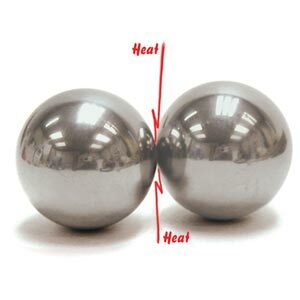 by: Tami O’Connor
by: Tami O’Connor
When two 1-pound, 2-inch diameter, chrome steel spheres are smashed together, enough heat is generated at the point of contact to burn a hole in ordinary paper! This dramatic demonstration has been a favorite of students in every grade for as long as I have been teaching!
 There are a few considerations when allowing students (especially younger ones) to conduct this activity on their own… First, the spheres are pretty heavy, so if they were either dropped on a foot or onto a nice tile floor, the result would not be good. Also, be sure that the only thing between the spheres is paper or aluminum foil. Fingers caught between the colliding spheres would not be happy. Finally, all participants should wear safety glasses, as it is not unusual for a small piece of paper to fly off after the spheres collide.
There are a few considerations when allowing students (especially younger ones) to conduct this activity on their own… First, the spheres are pretty heavy, so if they were either dropped on a foot or onto a nice tile floor, the result would not be good. Also, be sure that the only thing between the spheres is paper or aluminum foil. Fingers caught between the colliding spheres would not be happy. Finally, all participants should wear safety glasses, as it is not unusual for a small piece of paper to fly off after the spheres collide.



 Posted by Tami O'Connor
Posted by Tami O'Connor  by: Martin Sagendorf
by: Martin Sagendorf
